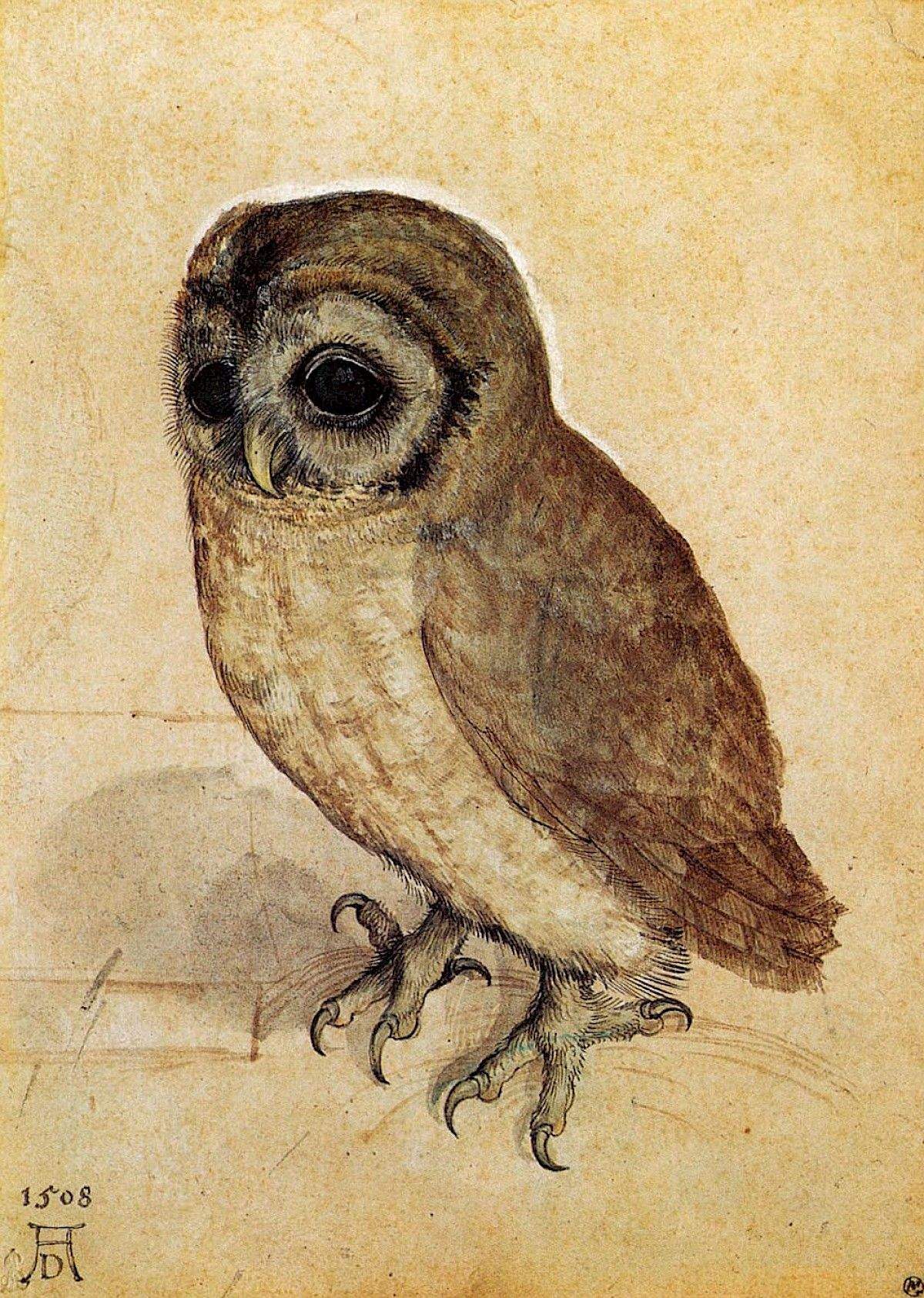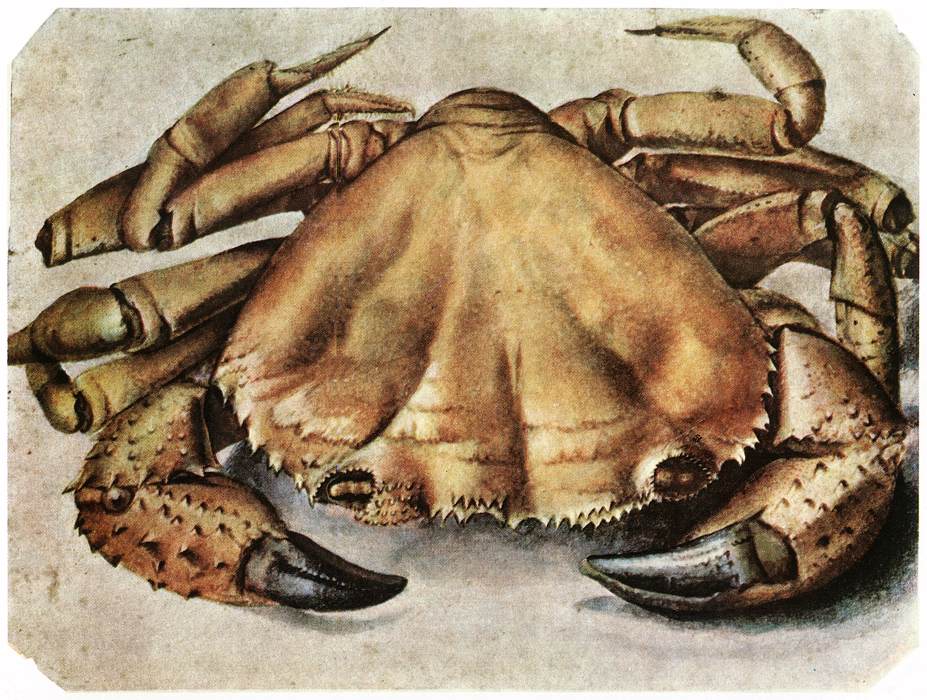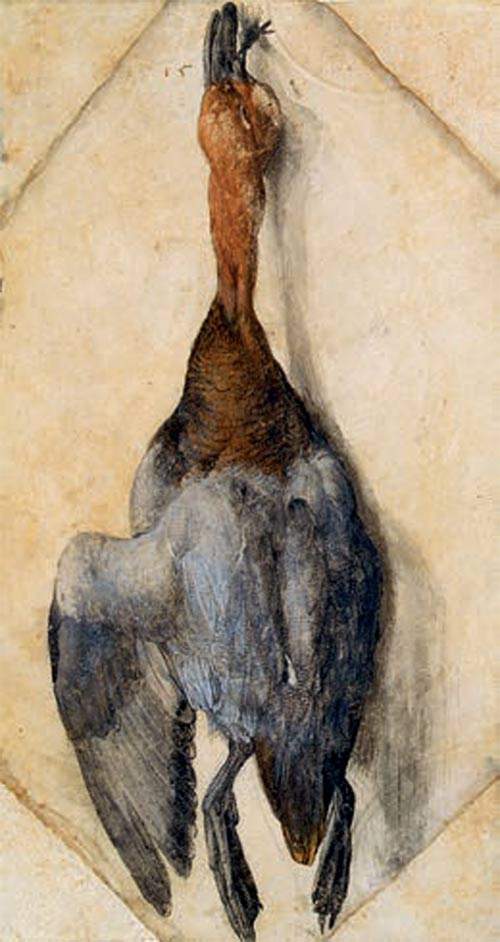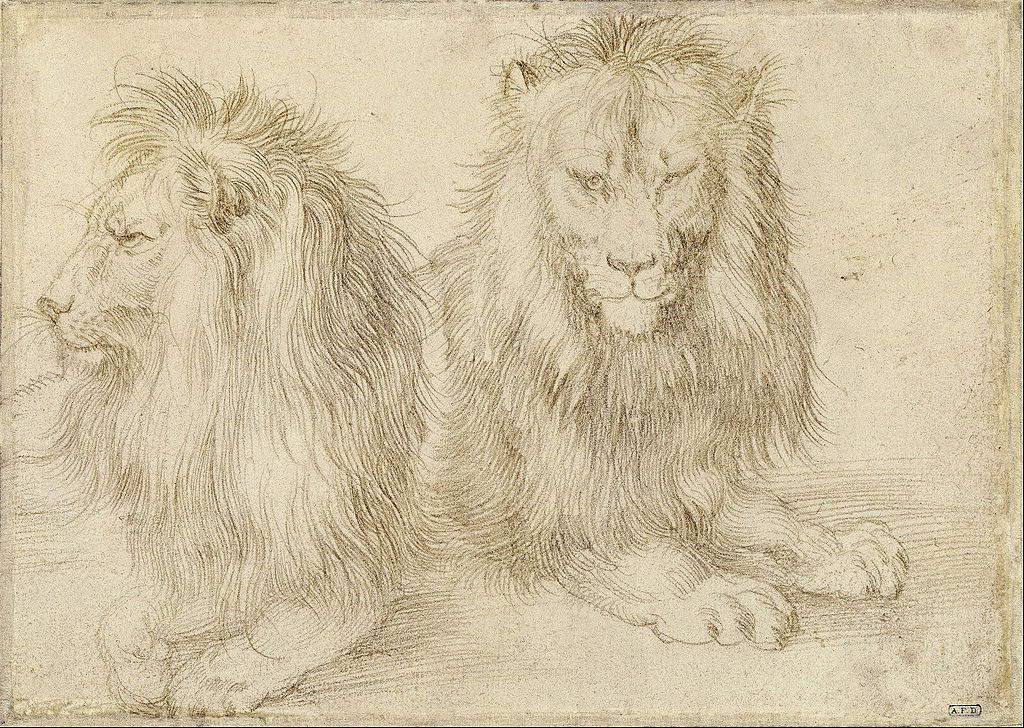One of the best-known strands of Albrecht Dürer ’s (Nuremberg, 1471 - 1528) art is his production of studies of plants and animals, which even today are surprising for their high naturalism: these are drawings but also works done in watercolor (the most famous ones). Dürer did not, however, have the primacy of nature studies: the German artist began to take an interest in these subjects around the age of 30, between the end of the 15th century and his departure for a trip to Italy in 1505, but nature had become a source of interest for artists since at least the mid-15th century. The areas where studies of plants and animals became widespread were northern Italy (meals think of the works of Pisanello, but one could also go back as far as the fourteenth century by Giovannino de’ Grassi), Flanders, and Germany itself, where a number of artists of the generation preceding Dürer’s worked, namely Hans Pleydenwurff (Bamberg, c. 1420 - Nuremberg, 1472), Martin Schongauer (Colmar, c. 1448 - Breisach am Rhein, 1491) and others capable of realistic natural descriptions. Dürer was formed in the wake of this tradition, but his studies of nature are characterized by his “research conducted with a new sense of ’scientificity,’” wrote art historian Bernard Aikema in the catalog of the major exhibition on Dürer held in Milan, at the Palazzo Reale, n2l 2018.
“In historiography, the years around 1500 are considered the period of discoveries,” Aikema says, “when the authority of the great written tradition (Aristotle, even the Bible) was for the first time questioned by a few enlightened minds, who pitted it against the evidence of empirical observation. Instead of blindly trusting the truth (eternal, total, absolute, unquestionable, a closed box) offered by the ancient canonical texts, these innovators were beginning to explore the universe with their own senses, discovering, precisely, a new world, which turned out to be based on a system structured by rules, by numbers.” Dürer’s personality, according to the scholar, is therefore to be considered a great protagonist of this historical moment: the German artist was not an intellectual, he did not know Latin, and on his side he usually had his own technique, intuition and curiosity, similar to that which animated Leonardo da Vinci’s research. Dürer’s attitude is comparable to that of the great Tuscan artist: as with Leonardo, for Dürer art is a means of investigating nature (“Thanks to education through painting,” said the Nuremberg artist, “the measurement of earth, water, and stars has become comprehensible, and painting will facilitate this understanding for many more people.”).
The novelty of Dürer’s studies of plants and animals is precisely inherent in the artist’s attitude, and it is in the assumptions of his research that one must find the main difference from an artist such as Pisanello, who was able to produce similarly very verisimilar studies of animals and was animated by a curiositas that in some ways was similar to Dürer’s, but according to a viewpoint still bound to earlier patterns. For Pisanello, studies of animals were primarily large repertoires that were then to serve himself and his workshop to derive motifs from them that would later populate the finished paintings. Dürer’s way of confronting reality is also different from the way medieval bestiaries, collections of animal illustrations aimed primarily at providing the reader with descriptions of the symbolic and allegorical characteristics of animals, did, or even from the zoological treatises that became widespread as early as the thirteenth and fourteenth centuries (such as Albertus Magnus’ De animalibus ). “Such treatises,” Annamaria Ducci has written, “are largely dependent on classical (Aristotle) or indeed Arabic (Avicenna) sources, and they testify to a proto-scientific attitude, based on an essentially ’autopsy-like’ analysis of the anatomoia, physiology and especially the behavior of the various beasts. This is what is observed in the late specimens of the bestiaries, written in the vernacular, which linger on the naturalistic details of the species and anecdotal digressions relating to behavior, albeit often drawn from the courtly novellistics of the time.”
 |
| Albrecht Dürer, Flying Deer (1505; watercolor and gouache on paper, 141 x 114 mm; Los Angeles, J. Paul Getty Museum) |
 |
| Albrecht Dürer, Owl (1508; watercolor and gouache, 192 x 141 mm; Vienna, Albertina) |
 |
| Albrecht Dürer, Wing of a Jay (c. 1500; watercolor and gouache, 196 x 200 mm; Vienna, Albertina) |
What moves Dürer’s figures is thus the desire to find a scientific depiction based on direct observation of nature. His art and that of his contemporary Leonardo da Vinci (the two may have met), scholar Claudio Salsi has written, “sets itself the task of defining the visual reality of things; drawing, deployed with extreme spontaneity in all its sign potentialities, consciously adopted in their semantic value, is the ’primary means that serves to put into practice the cognitive vocation of painting’, even before the written word; despite the diversity of some graphic experiments, common is the predisposition for the scientific observation of nature, of the landscape of the micro and macrocosm.”
Dürer’s best-known animal is probably his Hare, signed and dated 1502, preserved in theAlbertina in Vienna: it is a watercolor that stands out, like so many of the German’s other works in the same vein, for its very high degree of realism. Dürer focuses mainly on the animal’s fur, taking care to render with extreme precision even the way the fur changes direction or shade of color and light. And, speaking of light, the way the artist illuminates his hare, with a light source coming from the left, also helps to infuse a great vitality into the composition, thus making it not only an accurate scientific study but also a valuable work of art (note, moreover, the reflection of a window in the hare’s eye: according to some, it is a sign that the artist, in his atelier, must have had a living specimen that he could study for his work). According to scholar Fritz Koreny, works such as these are evidence that Dürer operated as an artist and a scientist at the same time. The 16th century was the century in which science began to mature its descriptive paradigm, and since Dürer had recourse to direct observations, which he could moreover study in depth during his frequent travels (at the time, travel meant going long distances in nature, and on these occasions the artist certainly had the opportunity to study live the natural elements he included in his works), according to Koreny he can be counted among the “descriptive scientists.” The great fortune of the Hare is attested to by the large number of reproductions that the work knew as early as the 16th century.
Another famous sheet is the one with the sea crab (of the species Eriphia spinifrons, widespread in the Mediterranean) preserved at the Museum Boijmans van Beuningen in Rotterdam: “an authentic portrait,” according to Andrew John Martin. It is another veristic depiction: the artist lingers mainly on the animal’s carapace and its claws, leaving the side of some of its legs unseen instead. “The animal, with those very detached eyes from each other and the claws,” wrote Susanne Christine Martin, “surely must have fascinated the viewers at the time, who had never seen a crab before, but it must also have appeared rather disturbing to them.” This is for certain an animal that Dürer studied from life, and not based on earlier works (which did exist: think of Leonardo’s famous Crab Study preserved in the Wallraf-Richartz Museum in Cologne), and by observing a living animal: perhaps the artist had occasion to see a crab (and to depict it in action: the fact that it has one of its right legs raised suggests that it is moving from left to right) during his probable stay in Venice in 1494-1495. There is also no shortage of studies executed on dead animals in Dürer’s output, such as theDead Duck in the Gulbenkian Museum in Lisbon, a probably unfinished work that depicts a mallard described with great care by Dürer, especially when looking at the animal’s plumage. Martin related Dürer’s duck to a 1504 work by Jacopo de’ Barbari (Venice, 1450 - Mechelen, 1516), a Still Life with Partridge, Gloves and Crossbow Arrow, described by the scholar as an “incunabulum of the still life genre,” although it is unclear whether it was an accomplished painting or part of a larger project: it is likely that Dürer observed this (or other similar works) by Jacopo de’ Barbari in Venice and had “imported” this singular trompe-l’oeil to Nuremberg.
Dürer’s studies also include exotic animals: for example, the drawing with the Study of Two Lions preserved in the Kupferstichkabinett in Berlin is famous. Again, these are animals that the German artist was able to observe and study live: indeed, throughout Europe at the time there were collections of exotic animals that were kept in captivity. In the diary of his trip to the Netherlands (from 1520-1521, the year to which the Berlin studio dates), the artist recounted that he saw some lions in Ghent, and visited a zoo in Brussels where he had the opportunity to admire lions, a lynx, some monkeys, and a goat (it was mainly the big cats, however, that caught his attention the most). He did not, on the other hand, get to see an Indian rhinoceros, despite the fact that his print depicting this animal is one of his most famous works: in this case, the artist relied on the accounts of those who had seen the animal in person.
 |
| Albrecht Dürer, Hare (1502; watercolor and gouache on paper, 251 x 226 mm; Vienna, Albertina) |
 |
| Albrecht Dürer, Sea Crab (c. 1495; watercolor, 263 x 365 cm; Rotterdam, Museum Boijmans van Beuningen) |
 |
| Albrecht Dürer, Dead Duck (c. 1502-1504; opaque watercolor on parchment, 224 x 226 mm; Lisbon, Museu Calouste Gulbenkian) |
 |
| Albrecht Dürer, Study of Two Lions (1521; silver point on paper, 121 x 171 mm; Berlin, Kupferstichkabinett) |
 |
| Albrecht Dürer, Madonna of the Monkey (c. 1497-1498; burin, 191 x 124 mm; Private collection) |
Dürer’s studies had a considerable impact, also certified by the numerous copies and reproductions, as mentioned about the Hare. His works, scholar Andrea Bubenik has written, in the artistic field paved the way for the development of the still life genre, while on the scientific level his animalistic descriptions can be seen as precursors of the zoology of the advanced sixteenth century. And for such reasons, Dürer already at that time was seen as both an artist and a scientist, according to Bubenik. There were many artists who looked to him: think of Lucas Cranach the Elder, Albrecht Altdorfer, Lorenzo Lotto, Titian, Giulio Campagnola.
Andrew John Smith has pointed out that Dürer, however, exerted his influence not through watercolors and drawings, or at any rate these sheets played a minor part: they were in fact shown only to a few friends, colleagues and visitors, so only a small audience could observe and admire them. It was mainly his portraits, devotional paintings, altarpieces and, above all, engravings (already widespread in the 16th century) that spread the artist’s ideas (one might mention one, just by way of example: the Madonna of the Monkey, a typical Dürer work in which the devotional subject is combined with the presence of one or more animals). For Dürer, Smith concludes, it was essential “labitudine to focus constantly on the macrocosm and the microcosm, on the larger vistas and the details of nature, on the important and the seemingly insignificant. This ever-changing perception, this ’oscillating gaze’ that Dürer infuses into his art, distinguishes above all his studies of nature, but it also manifests itself in the naturalistic details that he includes in his major compositions. Perhaps it is precisely in this that larcane consists that makes these paintings particularly relatable to today’s viewers, who are highly sensitive to issues of environmental destruction and climate change.”
Warning: the translation into English of the original Italian article was created using automatic tools. We undertake to review all articles, but we do not guarantee the total absence of inaccuracies in the translation due to the program. You can find the original by clicking on the ITA button. If you find any mistake,please contact us.